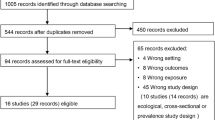Abstract
Objectives: The aim of the present study was to assess whether a high dietary intake of fatty fish from the Baltic Sea, contaminated with persistent organochlorine compounds, might increase the risk for congenital malformations and perinatal death. Methods: A cohort of fishermen's wives from the Swedish east coast (at the Baltic Sea) were linked to the Swedish Medical Birth Register (MBR), resulting in the identification of 1501 infants born in the period 1973–1991. A further linkage with the Swedish Registry of Congenital Malformations was performed. Similar linkages were made for a comparison group of fishermen's wives from the Swedish west coast, who gave birth to 3553 infants during the study period. The reproductive end points studied included congenital malformations, stillbirths, and early neonatal deaths. The expected numbers of these end points were calculated from the MBR data for the regional populations. Results: In the east coast cohort, 3.3% of the infants had some malformation diagnosis as compared with 5.0% of the west coast cohort. As compared with the general population, somewhat fewer malformations than expected were diagnosed in the east coast cohort (risk ratio 0.78, 95% CI 0.58–1.04). No specific malformation was overrepresented in the east coast cohort. The risk ratios for stillbirths and early neonatal deaths did not significantly differ from unity in any of the cohorts. Conclusions: The present results exclude in an unequivocal way an association between exposure to persistent organochlorines from fatty Baltic Sea fish and an increased risk for all congenital malformations and perinatal death. The limited power of the study design, however, does not allow the exclusion of slight risk excesses for some specific types of malformation.
Similar content being viewed by others
Author information
Authors and Affiliations
Additional information
Received: 28 May 1998 / Accepted: 22 October 1998
Rights and permissions
About this article
Cite this article
Rylander, L., Hagmar, L. No evidence for congenital malformations or prenatal death in infants born to women with a high dietary intake of fish contaminated with persistent organochlorines. Int Arch Occup Environ Health 72, 121–124 (1999). https://doi.org/10.1007/s004200050347
Issue Date:
DOI: https://doi.org/10.1007/s004200050347




